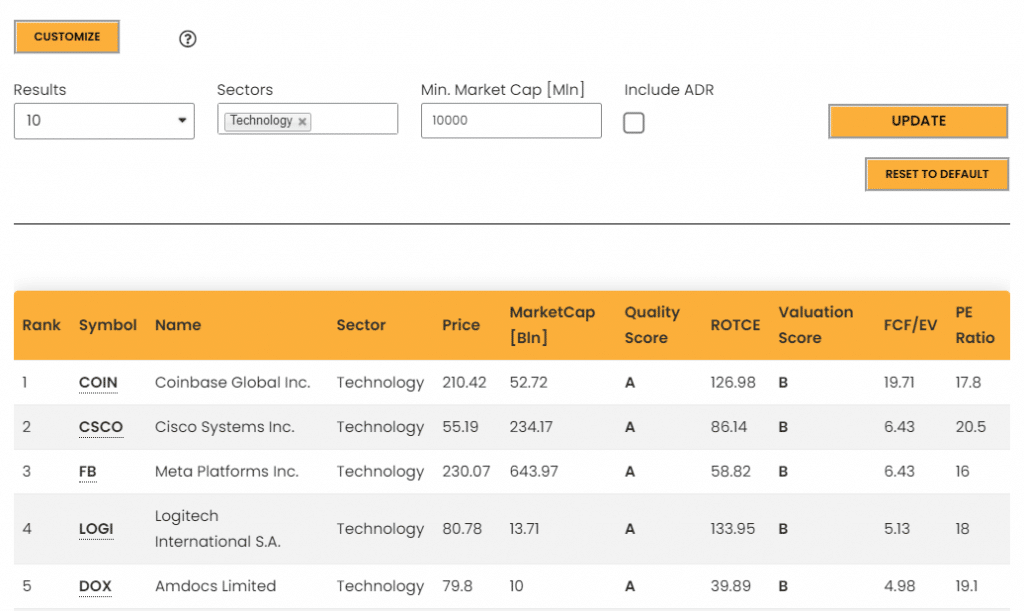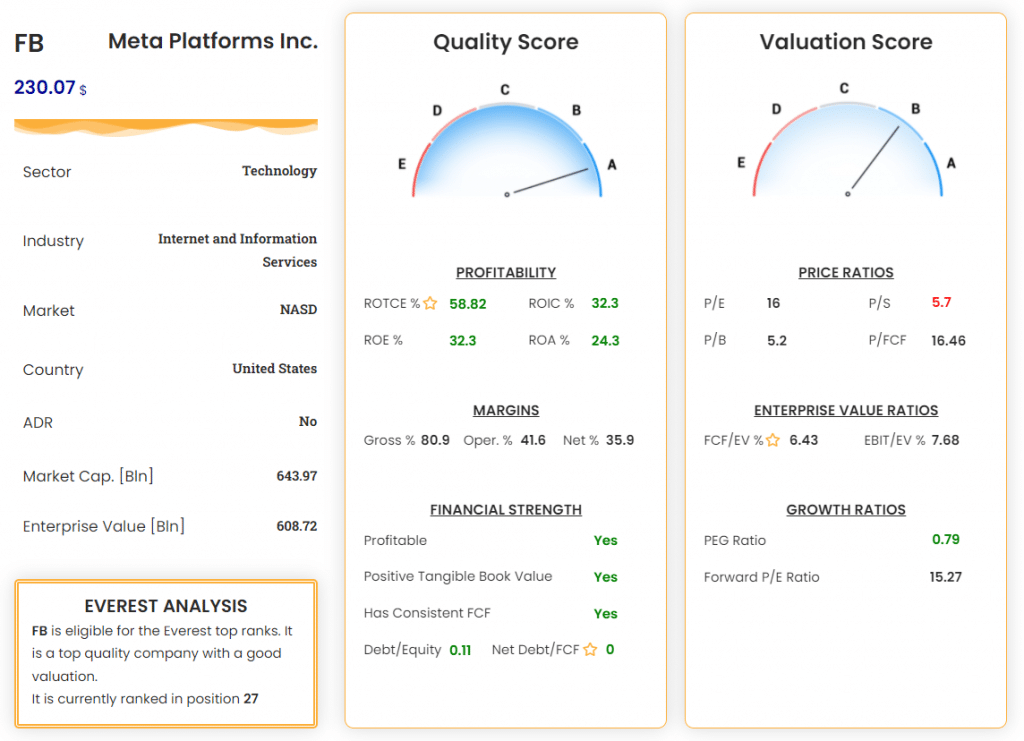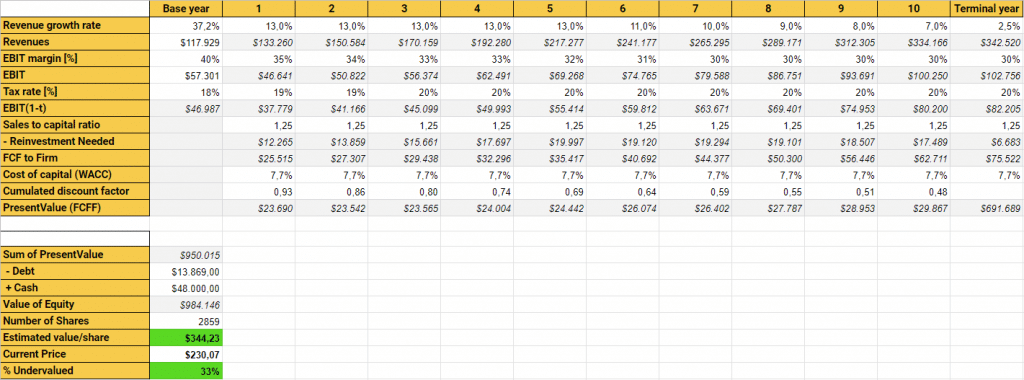- Meta Platforms has dropped approximately 30% since reporting fourth-quarter earnings results. Investors punished Facebook for the slowdown in expected growth, increasing competition and other risks that we are going to illustrate in this post.
- The Everest Formula recognizes the opportunity and suggests META as one of the most interesting stocks to analyze in the Technology sector.
- We are going to analyze Meta both from a quantitative and a qualitative point of view through the Everest Analyzer and a discounted cash flow model.
Are you interested in finding the best value stocks in each sector on your own? Premium members can use the Everest Screener to get the most valuable companies to invest in for each sector, everyday. Join now!
Introduction
In the last week a well-known company came under the radar of the Everest Screener in the Technology sector: Facebook, that recently has changed its name in Meta Platforms Inc.
Meta Platforms just jumped in the 3rd position of the Tech sector, just before Coinbase and Cisco, other 2 interesting stocks that deserve to be analyzed more in depth in the future. So let’s dig into the Facebook stock analysis, looking into its strengths, risks and valuation.
Meta Platforms – general overview and why it dropped
Meta Platforms doesn’t need any presentation: with their most famous products being Facebook, Instagram, Whatsapp and Messenger, they entered the lives of almost every people living in the developed world in the last 15 years. Meta was able to grow at a compounded annual growth rate of 40% in the last 10 years, and even in the last quarter Meta proved to be a great company, growing with impressive rates.
So why did it crash after the last report? A combination of factors have brought panic to investors:
- Expected revenue slowing down: Meta executive expects near future headwinds from both increased competition (like TikTok) and a shift of engagement within their apps towards video surfaces like Reels, which monetize at lower rates than Feed and Stories.
- Facebook app not growing anymore: Facebook application has had a stagnating user base for several quarters, and it’s falling out of favor within younger users.
- Growing expenses for the “Metaverse”: the new Reality Labs business is losing a consistent amount of money, and this loss is increasing quarter-by-quarter. Even if it is considered normal for a new investment to have a loss in the startup phase, the profitability break-even for the Metaverse seems far away, and many investors are doubtful about the eventually payoff of this segment.
- Apple’s new restrictive policies: In the last year, Apple rolled out a number of changes to IOS. One of them was known as “app tracking transparency” (ATT). ATT made it so that new app users have to opt in to having their data tracked. If they opt out, then companies like Meta cannot access crucial data for targeting people with their ads.
Investment thesis
While there is a lot of short-term headwinds around Meta, we can’t forget the long-term bullish drivers in Meta’s favor:
- Meta is the largest collection of social networks on the planet. While Facebook’s core site may be stagnating, “newer” platforms like Instagram are picking up the slack. Facebook’s apps have persisted for well over a decade.
- Meta is one of the companies with the most advanced designs on the Metaverse and augmented reality. No other companies is investing in R&D on the Metaverse like Meta is doing. If it turns out to be the future, Meta will have a huge competitive advantage.
- Meta is still immensely profitable. While Meta continues to build out the Metaverse (which will be a multi-year endeavor), its social media businesses continue to make profits and essentially subsidize these investments.
If you think that Meta will start to decline in the next years due to competition, regulations and growing issues, it is not the right investment for you. Conversely, If you think that Meta will emerge from the current headwinds thanks to its bullish drivers, the next chapters can be useful to get an idea if Meta could be a good investment. Let’s dig into the valuation of the company, using the Everest Analyzer to give a look to its metrics, and a discounted cash flow model to see if the company is undervalued at the current price.
A look at Meta Platforms using the Everest Analyzer
Quality score: Meta is one of the best managed companies that we can find in the whole market: a perfect balance sheet with virtually no debt, an extremely high profitability looking at any possible metric, and that has been consistent since its establishment. Moreover, Meta keeps huge margins even when compared to its main peers like Google or Apple. Meta earns a perfect quality score of A.
Valuation score: After the recent drop, Facebook has become an attractive stock even from a valuation point of view: the FCF/EV is more than 6%, one of the highest in the Technology sector. The P/E ratio of 16 is really low for a growing tech company, especially compared to the sector median(20.1) and its average P/E of the last 5 years (29.7). Only the Price/sales ratio registers a poor value of 5.7 (we prefer to see it under 5), that is also higher than the sector median of 2. Meta earns a valuation score of B, not perfect but still good.
From a relative pricing model, we believe that Meta Platforms deserves to be in a value investor portfolio: Meta is currently undervalued comparing both the quality and valuation metrics to competitors. Following the principles of Warren Buffett and Charlie Munger, we need to buy high quality companies when they are available at a bargain price, caused by temporary headwinds and investors fear. As they used to say, “Buy when there is blood in the streets”.
Valuation of Meta using DCF
Let’s put a value to Meta’s stock using a Discounted Cash Flow model. First of all we need to make some assumptions on the future of Meta:
- Future revenue growth: we make a very conservative estimation, supposing that Meta will slowdown its growth to 13% a year for next 5 years, then progressively reducing it to approach a perpetual growth rate of 2.5%/year from year 10, in line with the global economy growth. We are assuming that all the headwinds that it is facing and the maturity status that the company is approaching will make difficult to obtain the astounding annual growth of 40% that it achieved in the last years.
- Future operative margins: our hypothesis is that increasing competition will progressively shrink Meta’s operative margins to 30%, that is still a remarkable value, in line with its competitors.
- Future tax rate and sales to capital ratio: We assume that Meta will keep an average effective tax rate of 20% and sales to capital ratio of 1.25, in line with its history.
- Discount rate: we choose to discount the future cash flow with the Weighted Average Cost of Capital (WACC), that is the most reliable way to value a company, because it takes into account its risks and the overall market outlook. We computed a WACC of 7.7% for Meta.
With these input we are able to estimate year by year the expected free cash flow in hand of the company, from year 1 to year 10, in which we assume to sell the stock. Summing up all these discounted FCF, and subtracting debt and adding current cash, we obtain an intrinsic value for each share of 344.23$.
Given our calculations and the current price of 230.70$, the stock seems 33% undervalued. Here you can download the template used. You can modify the assumptions and extract your own intrinsic value.
Conclusions
After the recent sell-off, Meta has become a good stock to invest in. The Everest Formula recognized it and inserted Meta in the rank of the top stocks in the Technology sector. The Everest Formula indeed is not only a successful investing strategy, but also a powerful algorithm that can be used to seek out value stocks in any sector and any market condition.
So, what are you waiting for? Join our community!




